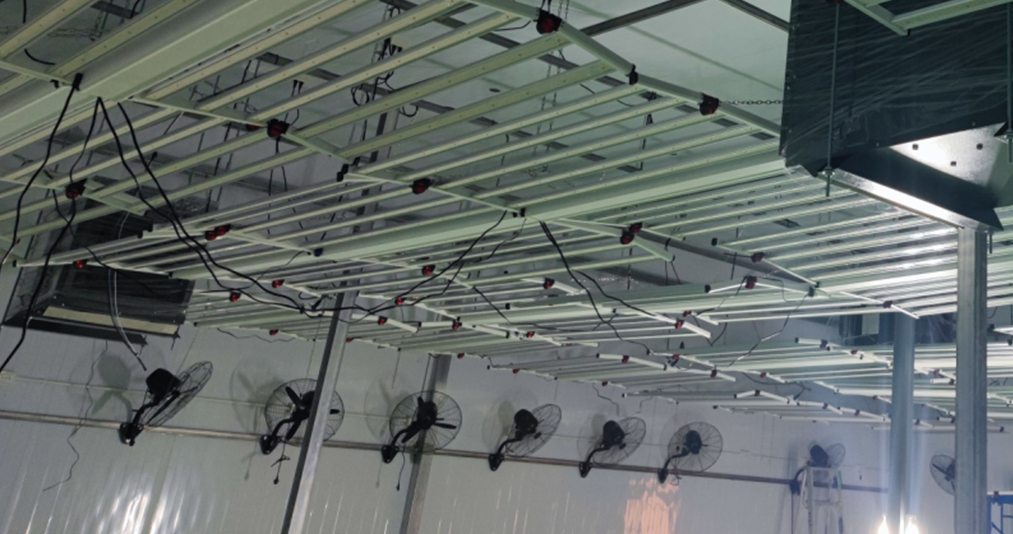How to Choose and Design LED Plant Lighting Plant Growth Lights?
2021-01-06
As an important branch of modern agriculture, the concept of plant factories has become very popular. In the indoor planting environment, plant lighting is an essential energy source for photosynthesis. LED plant lights have overwhelming advantages that traditional supplementary lights do not have, and will surely become the first choice for main or supplementary lights in large commercial applications such as vertical farms and greenhouses.
Plants are one of the most complex life forms on this planet. The planting of plants is simple, but difficult and complex. In addition to plant lighting, many variables affect each other, and balancing these variables is a superb art that growers need to understand and master. But in terms of plant lighting, there are still many factors that need to be carefully considered.
First, let's understand the spectrum of the sun and the absorption of the spectrum by plants. As can be seen from the figure below, the solar spectrum is a continuous spectrum, in which the blue and green spectrum is stronger than the red spectrum, and the visible light spectrum ranges from 380 to 780 nm. There are several key absorption factors in plant growth, and the light absorption spectra of several key auxins that affect plant growth are significantly different. Therefore, the application of LED plant growth lights is not a simple matter, but very targeted. Here it is necessary to introduce the concepts of the two most important photosynthetic plant growth elements.
The photosynthesis of plants relies on chlorophyll in leaf chloroplasts, which is one of the most important pigments related to photosynthesis. It exists in all organisms that can create photosynthesis, including green plants and prokaryotic plants. Blue-green algae (cyanobacteria) and eukaryotic algae. Chlorophyll absorbs the energy of light and synthesizes carbon dioxide and water into hydrocarbons.
Chlorophyll a is blue-green and mainly absorbs red light; chlorophyll b is yellow-green and mainly absorbs blue-violet light. Mainly to distinguish shade plants from sun plants. The ratio of chlorophyll b to chlorophyll a of shade plants is small, so shade plants can use blue light strongly and adapt to growing in shade. There are two strong absorptions of chlorophyll a and chlorophyll b: the red region with a wavelength of 630~680 nm, and the blue-violet region with a wavelength of 400~460 nm.
Carotenoids (carotenoids) is a general term for a class of important natural pigments, which are commonly found in yellow, orange-red or red pigments in animals, higher plants, fungi, and algae. More than 600 natural carotenoids have been discovered so far. Carotenoids produced in plant cells not only absorb and transfer energy to help photosynthesis, but also have the function of protecting cells from being destroyed by excited single-electron bond oxygen molecules. The light absorption of carotenoids covers the range of 303~505 nm. It provides the color of food and affects the human body's intake of food; in algae, plants and microorganisms, its color cannot be presented because it is covered by chlorophyll.
LED inter-plant lights are used to fill light inside plants
In the design and selection process of LED plant lights, there are several misunderstandings that need to be avoided, mainly in the following aspects.
Red and blue wavelength ratio of light wavelength
As the two main absorption regions for photosynthesis of two plants, the spectrum emitted by LED plant lights should be mainly red light and blue light. But it cannot be simply measured by the ratio of red to blue. For example, the ratio of red to blue is 4:1, 6:1, 9:1 and so on.
There are many different plant species with different habits, and different growth stages also have different light focus needs. The spectrum required for plant growth should be a continuous spectrum with a certain distribution width. It is obviously inappropriate to use a light source made of two specific wavelength chips of red and blue with a very narrow spectrum. In experiments, it was found that plants tend to be yellowish, the leaf stems are very light, and the leaf stems are very thin. There have been a large number of studies on the response of plants to different spectra in foreign countries, such as the effect of the infrared part on the photoperiod, the effect of the yellow-green part on the shading effect, and the effect of the violet part on the resistance to pests and diseases, nutrients and so on.
In actual applications, seedlings are often burned or withered. Therefore, the design of this parameter must be designed according to the plant species, growth environment and conditions.
2. Ordinary white light and full spectrum
The light effect "seen" by plants is different from the human eye. Our commonly used white light lamps are not able to replace the sunlight, such as the three-primary white light tubes widely used in Japan, etc. The use of these spectrums has a certain effect on the growth of plants, but the effect is not as good as the light source made by LEDs. .
For fluorescent tubes with three primary colors commonly used in previous years, although white is synthesized, the red, green, and blue spectra are separated, and the width of the spectrum is very narrow, and the continuous part of the spectrum is relatively weak. At the same time, the power is still relatively large compared to LEDs, 1.5 to 3 times the energy consumption. The full spectrum of LEDs designed specifically for plant lighting optimizes the spectrum. Although the visual effect is still white, it contains important light parts required for plant photosynthesis.
3. Illumination intensity parameter PPFD
The photosynthesis flux density (PPFD) is an important parameter to measure the intensity of light in plants. It can be expressed either by light quanta or radiant energy. It refers to the effective radiant flux density of light in photosynthesis, which represents the total number of light quanta incident on plant leaf stems in the wavelength range of 400 to 700 nm per unit time and unit area. The unit is μE·m-2·s-1 (μmol·m-2·s-1). The photosynthetically active radiation (PAR) refers to the total solar radiation with a wavelength in the range of 400 to 700 nm.
The light compensation point of the plant, also called the light compensation point, means that the PPFD needs to be higher than this point, the photosynthesis can be greater than the respiration, the growth of the plant is greater than the consumption, and the plant can grow. Different plants have different light compensation points, and it cannot be simply regarded as reaching a certain index, such as PPFD greater than 200μmol·m-2·s-1.
The light intensity reflected by the illuminance meter used in the past is the brightness, but because the spectrum of plant growth changes due to the height of the light source from the plant, the coverage of the light, and whether the light can pass through the leaves, etc., it is used as light when studying photosynthesis. Strong indicators are not precise enough, and PAR is now mostly used.
Generally, positive plant PPFD> 50 μmol·m-2·s-1 can start the photosynthesis mechanism; while shade plant PPFD only needs 20 μmol·m-2·s-1. Therefore, when installing LED plant lights, you can install and set according to this reference value, select the appropriate installation height, and achieve the ideal PPFD value and uniformity on the leaf surface.
4. Light formula
Light formula is a new concept recently proposed, which mainly includes three factors: light quality, light quantity and duration. Simply understand that light quality is the spectrum most suitable for plant photosynthesis; light quantity is the appropriate PPFD value and uniformity; duration is the cumulative value of irradiation and the ratio of day to night time. Dutch agriculturists have found that plants use the ratio of infrared to red light to judge the day and night changes. The infrared ratio increases significantly at sunset, and plants respond quickly to sleep. Without this process, it will take several hours for plants to complete this process.
In practical applications, it is necessary to accumulate experience through testing and select the best combination.







